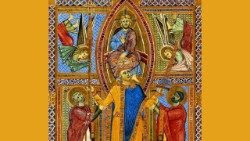SAINT OF THE DAY JULY 13 ST.HENRY II, EMPEROR, ST. ESDRAS, SCRIBE
SAINT OF THE DAY JULY 13
ST.HENRY II, EMPEROR
Henry lived at the turn of the first millennium, and reigned as Holy Roman Emperor from 1014. He was the last member of the Ottonian dynasty. He dedicated his life to building up both the Church and his own realm. Henry is considered a model of good governance, and is the patron saint of rulers.
It’s difficult to understand the life of St Henry without considering the strong Christian formation he received from his childhood. Henry was born in Bamberg in 973, the son of the Duke of Bavaria. He grew up in a profoundly Christian atmosphere, receiving his education first from the canons at Hildesheim, and later, in Ratisbon (now Regensburg), from St Wolfgang, the Bishop of that city.
He succeeded his father as duke; and later his cousin, Otto III, as King of Germany in 1002. Two years later, he added the title King of Italy. In 1014 Henry was crowned Holy Roman Emperor by Pope Benedict VIII.
The Emperor and the Cluniac reform
Henry’s support for the moral reform begun from the Abbey of Cluny was significant. Cluny’s abbot, St Odilo, was also one of Henry’s counsellors. The Cluniac Reforms affected not only monastic life, but the whole life of the Church. He helped the Church combat simony (the buying and selling of ecclesiastical goods and offices), and promoted clerical celibacy. In 1022, together with Pope Benedict VIII, Henry presided over the Council of Pavia, which published 7 canons against clerical concubinage, and in favour of the defence of the patrimony of the Church. He restored episcopal sees, and founded the Diocese of Bamburg. His interest in the liturgy can be seen in his desire to introduce recitation of the Creed to the Sunday Mass.
Political actions
Henry was also a decisive political leader. The early part of his reign required him to defend his claim to the throne against various rebellious lords. He allied himself with pagan Slavic tribes against the Polish Duke Boleslaw, a decision for which he was criticized. In Italy he defeated Arduin of Ivrea, who had been elected King of Italy (although the title was not recognized universally). Henry also came into conflict with the Byzantine empire.
Love for Cunigunde
One of the most striking aspects of Henry’s life was his love for his wife, St Cunigunde. The couple did not have children, which has given rise to the belief that the spouses had taken a mutual vow of chastity, although some historians dispute this. In any case, contrary to a common medieval practice, Saint Henry did not repudiate his wife; his decision to remain with her contributed in no small part to his reputation for sanctity. His fidelity bore witness to his deep love for his wife, and his profound respect for the Sacrament of Marriage.
Henry II was canonized by Pope Eugene III in 1146.
ST. ESDRAS, SCRIBE
Ezra is the high priest who is one of the chief protagonists of the Old Testament books of Ezra and Nehemiah. The Babylonian Exile had weakened the faith of the people. When the Jews returned to their land, Ezra worked to restore the faith and traditions of the Covenant.


Comments
Post a Comment